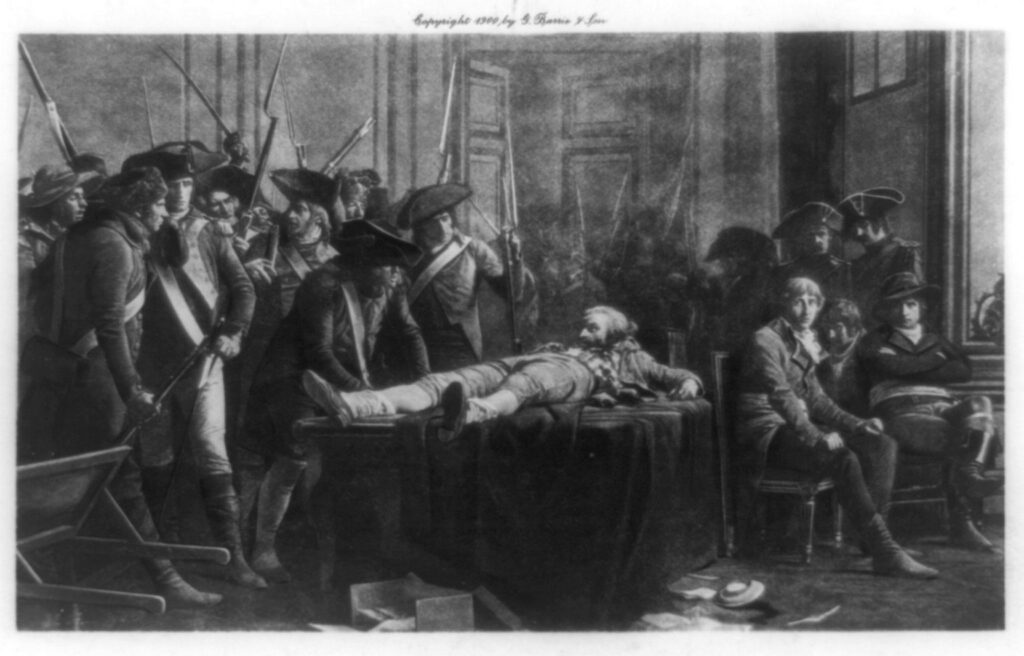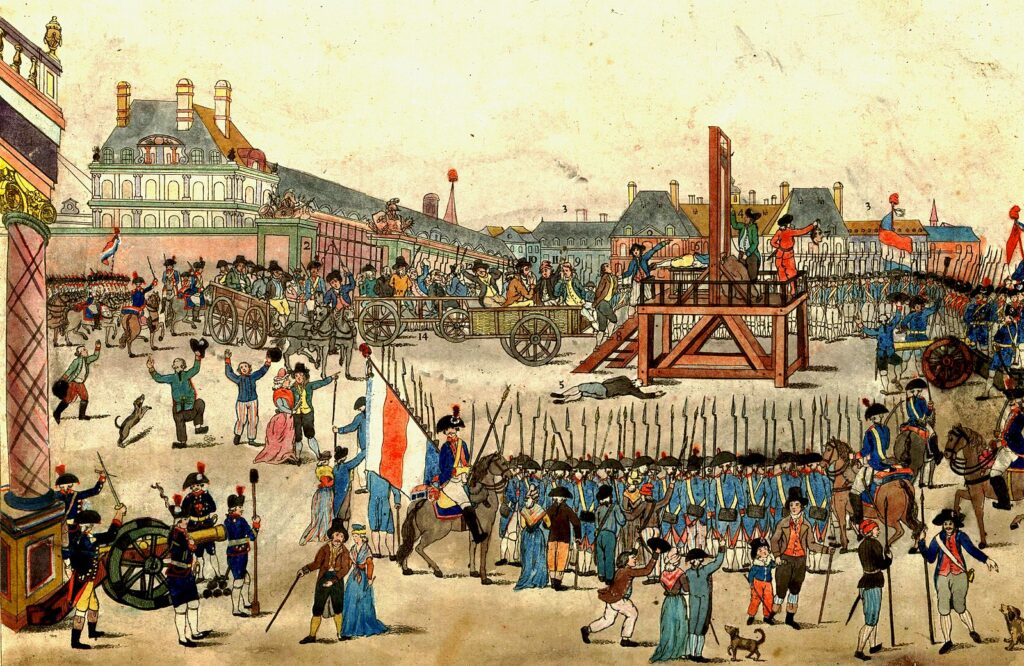On July 27, 1794, the Jacobin leader Maximilian Robespierre was finally arrested. He led a Reign of Terror that resulted in the deaths of thousands of people.
After months of marching suspected royalists to the guillotine, it would soon be his turn to face the same fate as so many others. At first, he managed to flee from his captors. But after taking refuge in the Hotel de Ville he heard the news that he had been declared an outlaw.
He decided to shoot himself in the head. The bullet didn’t kill him, but it shattered his jaw. Clutching his bleeding face, Robespierre was out of options. French troops stormed into his room and took him away.
The next day, he was guillotined in front of a crowd of cheering Parisians. The Reign of Terror had finally ended. But this was far from the end of the bloodshed.
After Robespierre’s death, a new faction of more conservative forces took power and tried to roll back some of the more radical changes made by the Jacobins. They were known as the Thermidorians for the name of the month in which they came to power (according to the revolutionary calendar).
During their four years in power, the Thermidorians tried to put the lid back on the revolutionary fervor, but in the end, they too were toppled.

The Reign of Terror and the Fall of Robespierre
By 1793, the French Revolution had been underway for six years and things were taking a dark turn.
The revolutionaries were split into two factions – the moderate Girondins and the more radical faction known as the Mountain. It was this second, more radical group, with Robespierre as leader, who eventually took control of the government.
The Mountain ruled through what was known as the Committee of Public Safety. This executive committee worked with local committees to root out any “suspects,” who were deemed to be a threat to the revolution.
When rounding up these suspected enemies of the revolution, the Committee often cast a wide net. There were many crimes for which a person could be brought before the court.
They ranged from being seen as a royalist, a supporter of the Catholic church, hoarding supplies, or calling a neighbor ‘monsieur’ rather than the more egalitarian term, “citizen.” Once denounced as being a suspect, the person would be taken before the Revolutionary Tribunal where they were either acquitted or sent for execution.
During the months-long reign of terror, which lasted until the death of Maximilien Robespierre, somewhere between 30,000 and 50,000 people were sent to the guillotine. The fear and chaos that the Reign of Terror unleashed on the populace is what set the stage for the Thermidorian Reaction.
The Thermidorian Reaction
In the last month of the Reign of Terror, 1,400 people were executed. Robespierre and the rest of the Committee on Public Safety were making it easier and easier to send someone to the guillotine.
With the Paris prisons full of “suspects” they tried to expedite the judicial process by removing the need for evidence in trials. This meant that someone could now go straight from being denounced to being sent to the guillotine with almost no chance of defending themselves.
With paranoia and fear at a fever pitch, members of the provisional government were gotten on the wrong side of Robespierre and began to suspect that they would be next. They decided to strike against him before he could send them to their deaths.
Maximilien Robespierre and 80 of his closest supporters were executed near the end of July 1794. This was nearly nine months after the Reign of Terror had begun. Soon, a new group of men came to power.
They set to work dismantling the old system of terror by taking away much of the Committee’s powers and rounding up many of the perpetrators of the Terror’s violence. In the aftermath, many Jacobins were executed.

As mentioned earlier, this new political group became known as the Thermidorians because the transition took place during the revolutionary month of Thermidor – that is, July 1794.
Once the Thermidorians came to power they replaced terror with justice, repealing many of the laws that had facilitated the Reign of Terror. Rather than push the pendulum in the other direction and go about seeking vengeance against the Jacobins, they tried to focus on creating order and fixing the economic problems that were currently plaguing the nation.
However, not everyone was quite ready to turn the page. For many people, the memory of the bloodletting was too fresh. This section of the population was not content with justice – they wanted revenge.
The White Terror
While anti-Jacobin sentiment was rife throughout all of France, one of the largest and most visible signs of this hatred came in the form of the “muscadins.” The muscadins were a group that roamed the streets of French cities, rooting out any sign of Jacobins.
They broke into Jacobin meetings and attacked anyone they found in attendance. They grabbed people off the street – both men and women – and beat them with wooden clubs if they suspected them of being former Jacobins.
The muscadins – which means “wearing musk perfume” – dressed in silk stockings and wide-brimmed hats to mock the Jacobins, who had been mostly made up of people from the bourgeoisie.
These groups of anti-Jacobin men could be vicious, yet the Thermidorian government did nothing to stop the violence. At the height of muscadin raids on Jacobin meetings, the Thermidorian leaders decided to ban the Jacobins from gathering rather than try to punish the muscadins for their violent behavior.
After a failed Jacobin uprising on April 1, 1795, the anti-Jacobin violence became even more pronounced. Gangs now kidnapped, lynched, and butchered Jacobin sympathizers throughout the country.
In one case, an angry crowd broke into a prison in the city of Lyon and massacred 120 Jacobin prisoners. Between April and July of that year, some 2,000 suspected Jacobins were murdered.
End of the Thermidorians
Eventually, many Parisians became fed up with the constant threat of violence. It was making a terrible economic situation even more precarious.
On May 20th, 1795, some 20,000 people joined in an insurrection that demanded a return to the 1793 constitution. This was written by the Jacobins (but never implemented). They also demanded bread for the starving population.
This mob stormed the National Convention. The next day they were confronted by the French military. To avoid bloodshed, the Thermidorians promised the rebels that they would be given bread if they put down their weapons. They agreed.
The Thermidorians, however, did not follow through on their promise. Instead, they rounded up the ringleaders of the uprising and had most of them executed or thrown in prison. They then went about creating their own, more conservative constitution, which they implemented on August 22nd, 1795.
That constitution remained in place until a successful coup finally ended the Thermidorian reign in 1799. That coup allowed a commander named Napoleon Bonaparte to come to power as part of the three-man consulate.
It would not be long before he became emperor of France.

